Siyuan Liu
Institute of Remote Sensing and Geographic Information System, School of Earth and Space Sciences, Peking University
SoulX-LiveTalk: Real-Time Infinite Streaming of Audio-Driven Avatars via Self-Correcting Bidirectional Distillation
Dec 31, 2025Abstract:Deploying massive diffusion models for real-time, infinite-duration, audio-driven avatar generation presents a significant engineering challenge, primarily due to the conflict between computational load and strict latency constraints. Existing approaches often compromise visual fidelity by enforcing strictly unidirectional attention mechanisms or reducing model capacity. To address this problem, we introduce \textbf{SoulX-LiveTalk}, a 14B-parameter framework optimized for high-fidelity real-time streaming. Diverging from conventional unidirectional paradigms, we use a \textbf{Self-correcting Bidirectional Distillation} strategy that retains bidirectional attention within video chunks. This design preserves critical spatiotemporal correlations, significantly enhancing motion coherence and visual detail. To ensure stability during infinite generation, we incorporate a \textbf{Multi-step Retrospective Self-Correction Mechanism}, enabling the model to autonomously recover from accumulated errors and preventing collapse. Furthermore, we engineered a full-stack inference acceleration suite incorporating hybrid sequence parallelism, Parallel VAE, and kernel-level optimizations. Extensive evaluations confirm that SoulX-LiveTalk is the first 14B-scale system to achieve a \textbf{sub-second start-up latency (0.87s)} while reaching a real-time throughput of \textbf{32 FPS}, setting a new standard for high-fidelity interactive digital human synthesis.
RAP: Real-time Audio-driven Portrait Animation with Video Diffusion Transformer
Aug 07, 2025Abstract:Audio-driven portrait animation aims to synthesize realistic and natural talking head videos from an input audio signal and a single reference image. While existing methods achieve high-quality results by leveraging high-dimensional intermediate representations and explicitly modeling motion dynamics, their computational complexity renders them unsuitable for real-time deployment. Real-time inference imposes stringent latency and memory constraints, often necessitating the use of highly compressed latent representations. However, operating in such compact spaces hinders the preservation of fine-grained spatiotemporal details, thereby complicating audio-visual synchronization RAP (Real-time Audio-driven Portrait animation), a unified framework for generating high-quality talking portraits under real-time constraints. Specifically, RAP introduces a hybrid attention mechanism for fine-grained audio control, and a static-dynamic training-inference paradigm that avoids explicit motion supervision. Through these techniques, RAP achieves precise audio-driven control, mitigates long-term temporal drift, and maintains high visual fidelity. Extensive experiments demonstrate that RAP achieves state-of-the-art performance while operating under real-time constraints.
Marrying Autoregressive Transformer and Diffusion with Multi-Reference Autoregression
Jun 11, 2025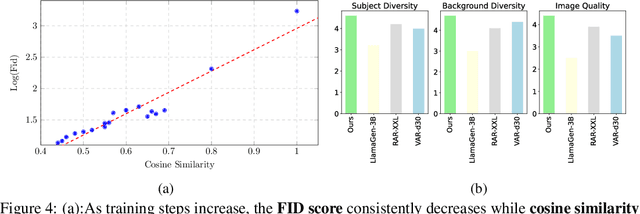


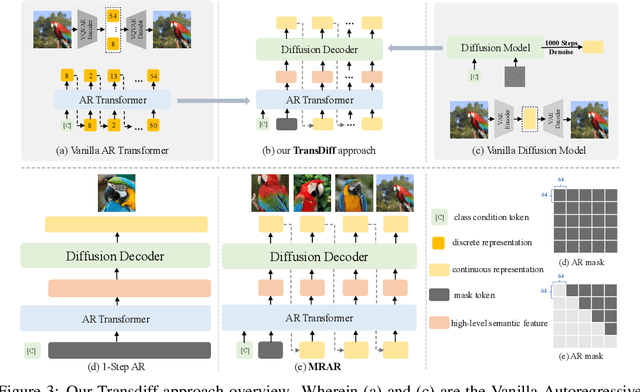
Abstract:We introduce TransDiff, the first image generation model that marries Autoregressive (AR) Transformer with diffusion models. In this joint modeling framework, TransDiff encodes labels and images into high-level semantic features and employs a diffusion model to estimate the distribution of image samples. On the ImageNet 256x256 benchmark, TransDiff significantly outperforms other image generation models based on standalone AR Transformer or diffusion models. Specifically, TransDiff achieves a Fr\'echet Inception Distance (FID) of 1.61 and an Inception Score (IS) of 293.4, and further provides x2 faster inference latency compared to state-of-the-art methods based on AR Transformer and x112 faster inference compared to diffusion-only models. Furthermore, building on the TransDiff model, we introduce a novel image generation paradigm called Multi-Reference Autoregression (MRAR), which performs autoregressive generation by predicting the next image. MRAR enables the model to reference multiple previously generated images, thereby facilitating the learning of more diverse representations and improving the quality of generated images in subsequent iterations. By applying MRAR, the performance of TransDiff is improved, with the FID reduced from 1.61 to 1.42. We expect TransDiff to open up a new frontier in the field of image generation.
Infi-Med: Low-Resource Medical MLLMs with Robust Reasoning Evaluation
May 29, 2025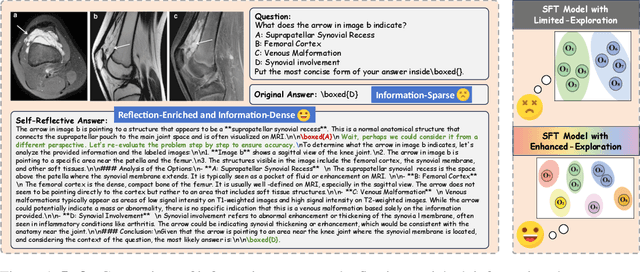
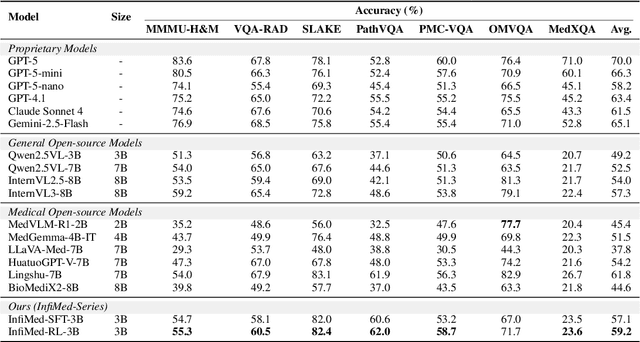


Abstract:Multimodal large language models (MLLMs) have demonstrated promising prospects in healthcare, particularly for addressing complex medical tasks, supporting multidisciplinary treatment (MDT), and enabling personalized precision medicine. However, their practical deployment faces critical challenges in resource efficiency, diagnostic accuracy, clinical considerations, and ethical privacy. To address these limitations, we propose Infi-Med, a comprehensive framework for medical MLLMs that introduces three key innovations: (1) a resource-efficient approach through curating and constructing high-quality supervised fine-tuning (SFT) datasets with minimal sample requirements, with a forward-looking design that extends to both pretraining and posttraining phases; (2) enhanced multimodal reasoning capabilities for cross-modal integration and clinical task understanding; and (3) a systematic evaluation system that assesses model performance across medical modalities and task types. Our experiments demonstrate that Infi-Med achieves state-of-the-art (SOTA) performance in general medical reasoning while maintaining rapid adaptability to clinical scenarios. The framework establishes a solid foundation for deploying MLLMs in real-world healthcare settings by balancing model effectiveness with operational constraints.
ELDeR: Getting Efficient LLMs through Data-Driven Regularized Layer-wise Pruning
May 23, 2025Abstract:The deployment of Large language models (LLMs) in many fields is largely hindered by their high computational and memory costs. Recent studies suggest that LLMs exhibit sparsity, which can be used for pruning. Previous pruning methods typically follow a prune-then-finetune paradigm. Since the pruned parts still contain valuable information, statically removing them without updating the remaining parameters often results in irreversible performance degradation, requiring costly recovery fine-tuning (RFT) to maintain performance. To address this, we propose a novel paradigm: first apply regularization, then prune. Based on this paradigm, we propose ELDeR: Getting Efficient LLMs through Data-Driven Regularized Layer-wise Pruning. We multiply the output of each transformer layer by an initial weight, then we iteratively learn the weights of each transformer layer by using a small amount of data in a simple way. After that, we apply regularization to the difference between the output and input of the layers with smaller weights, forcing the information to be transferred to the remaining layers. Compared with direct pruning, ELDeR reduces the information loss caused by direct parameter removal, thus better preserving the model's language modeling ability. Experimental results show that ELDeR achieves superior performance compared with powerful layer-wise structured pruning methods, while greatly reducing RFT computational costs. Since ELDeR is a layer-wise pruning method, its end-to-end acceleration effect is obvious, making it a promising technique for efficient LLMs.
UTTG_ A Universal Teleoperation Approach via Online Trajectory Generation
Apr 28, 2025Abstract:Teleoperation is crucial for hazardous environment operations and serves as a key tool for collecting expert demonstrations in robot learning. However, existing methods face robotic hardware dependency and control frequency mismatches between teleoperation devices and robotic platforms. Our approach automatically extracts kinematic parameters from unified robot description format (URDF) files, and enables pluggable deployment across diverse robots through uniform interfaces. The proposed interpolation algorithm bridges the frequency gap between low-rate human inputs and high-frequency robotic control commands through online continuous trajectory generation, \n{while requiring no access to the closed, bottom-level control loop}. To enhance trajectory smoothness, we introduce a minimum-stretch spline that optimizes the motion quality. The system further provides precision and rapid modes to accommodate different task requirements. Experiments across various robotic platforms including dual-arm ones demonstrate generality and smooth operation performance of our methods. The code is developed in C++ with python interface, and available at https://github.com/IRMV-Manipulation-Group/UTTG.
NTIRE 2025 Challenge on Day and Night Raindrop Removal for Dual-Focused Images: Methods and Results
Apr 19, 2025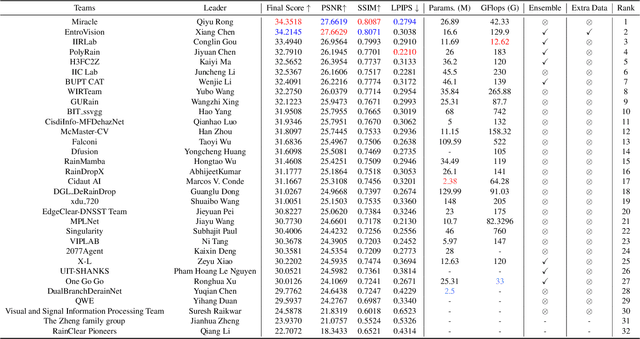
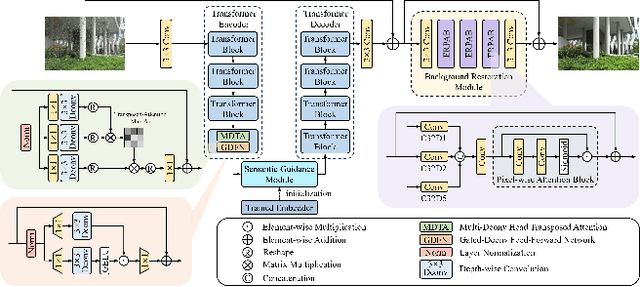
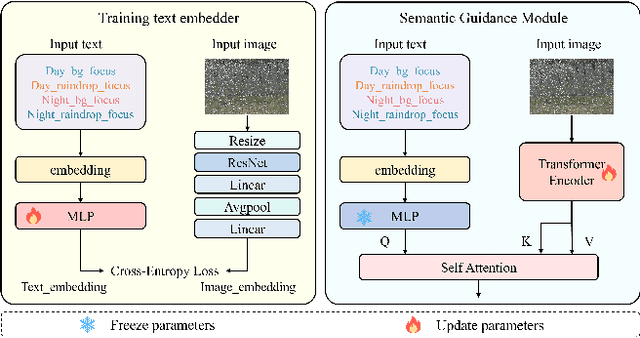

Abstract:This paper reviews the NTIRE 2025 Challenge on Day and Night Raindrop Removal for Dual-Focused Images. This challenge received a wide range of impressive solutions, which are developed and evaluated using our collected real-world Raindrop Clarity dataset. Unlike existing deraining datasets, our Raindrop Clarity dataset is more diverse and challenging in degradation types and contents, which includes day raindrop-focused, day background-focused, night raindrop-focused, and night background-focused degradations. This dataset is divided into three subsets for competition: 14,139 images for training, 240 images for validation, and 731 images for testing. The primary objective of this challenge is to establish a new and powerful benchmark for the task of removing raindrops under varying lighting and focus conditions. There are a total of 361 participants in the competition, and 32 teams submitting valid solutions and fact sheets for the final testing phase. These submissions achieved state-of-the-art (SOTA) performance on the Raindrop Clarity dataset. The project can be found at https://lixinustc.github.io/CVPR-NTIRE2025-RainDrop-Competition.github.io/.
1-Tb/s/λ Transmission over Record 10714-km AR-HCF
Apr 02, 2025Abstract:We present the first single-channel 1.001-Tb/s DP-36QAM-PCS recirculating transmission over 73 loops of 146.77-km ultra-low-loss & low-IMI DNANF-5 fiber, achieving a record transmission distance of 10,714.28 km.
Representation Learning, Large-Scale 3D Molecular Pretraining, Molecular Property
Mar 13, 2025Abstract:Molecular pretrained representations (MPR) has emerged as a powerful approach for addressing the challenge of limited supervised data in applications such as drug discovery and material design. While early MPR methods relied on 1D sequences and 2D graphs, recent advancements have incorporated 3D conformational information to capture rich atomic interactions. However, these prior models treat molecules merely as discrete atom sets, overlooking the space surrounding them. We argue from a physical perspective that only modeling these discrete points is insufficient. We first present a simple yet insightful observation: naively adding randomly sampled virtual points beyond atoms can surprisingly enhance MPR performance. In light of this, we propose a principled framework that incorporates the entire 3D space spanned by molecules. We implement the framework via a novel Transformer-based architecture, dubbed SpaceFormer, with three key components: (1) grid-based space discretization; (2) grid sampling/merging; and (3) efficient 3D positional encoding. Extensive experiments show that SpaceFormer significantly outperforms previous 3D MPR models across various downstream tasks with limited data, validating the benefit of leveraging the additional 3D space beyond atoms in MPR models.
"My Grade is Wrong!": A Contestable AI Framework for Interactive Feedback in Evaluating Student Essays
Sep 11, 2024



Abstract:Interactive feedback, where feedback flows in both directions between teacher and student, is more effective than traditional one-way feedback. However, it is often too time-consuming for widespread use in educational practice. While Large Language Models (LLMs) have potential for automating feedback, they struggle with reasoning and interaction in an interactive setting. This paper introduces CAELF, a Contestable AI Empowered LLM Framework for automating interactive feedback. CAELF allows students to query, challenge, and clarify their feedback by integrating a multi-agent system with computational argumentation. Essays are first assessed by multiple Teaching-Assistant Agents (TA Agents), and then a Teacher Agent aggregates the evaluations through formal reasoning to generate feedback and grades. Students can further engage with the feedback to refine their understanding. A case study on 500 critical thinking essays with user studies demonstrates that CAELF significantly improves interactive feedback, enhancing the reasoning and interaction capabilities of LLMs. This approach offers a promising solution to overcoming the time and resource barriers that have limited the adoption of interactive feedback in educational settings.
 Add to Chrome
Add to Chrome Add to Firefox
Add to Firefox Add to Edge
Add to Edge